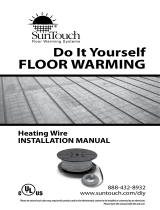
INSTALLING THE THERMOSTAT
If you are using a thermostat with a oor sensor, tape the sensor to the
bottom surface of the Environ heating panel, centered between two
heater wires, at least 6” into the heated area. If the carpet and pad
are installed over a wood suboor, the sensor probe can be placed in
a quarter-sized area hollowed out of the carpet pad directly under the
ex roll. Once the ex rolls have been placed in their nal position,
hollow out this area at least 6” into the mat, centered between 2 heating
wires. Place the sensor in this area and run the sensor wire back to the
thermostat in a separate channel in the carpet pad. Place duct tape
over this channel and the hollowed-out area and sensor probe. The
“heater wires” within the heater are identied as raised parallel lines,
either 2” or 3” apart. The sensor wire can cross over the foil heater
wires. The sensor probe must use a jacketed wire, this wire needs to
be rated 80°C minimum.
INSTALLING THE FLEX ROLLS
Once the carpet cushion has been tted in the normal manner, remove your Environ
Flex rolls from the packaging tube, unroll and cut and turn it completely and place
it in the required position on top of the carpet cushion.
When positioning the Flex rolls on the carpet cushion, be aware of the following:
• Keep it at least 1’ from any edge of the area to be carpeted, (to prevent the
spikes of the power stretcher damaging the panel when the carpet is being
tted);
• Ensure the power supply cables can reach the thermostat point to which
they will be connected;
• Wherever possible, run the power supply cables parallel or at right angles to
the walls, and avoid high-trafc areas;
• Wherever possible, keep the corner where the power supply cable enters the
Flex roll away from high trafc areas;
• NEVER run the power supply cables under or over the Flex rolls;
• Flex rolls can only positioned cable-side down;
• When tting more than one Flex roll in a room, the Flex rolls MUST NOT
OVERLAP, as overheating will result.
• VERIFY the Flex rolls received are the correct voltage.
Smooth out the Flex rolls and adhere the heater to the underlay with adhesive tape
as set out below. Any adhesive tape will do.
After deciding the route that your power supply cables will take from
the Flex roll to the point of supply, cut a 1/4”-wide channel in the carpet
cushion along this route and drop the power supply cables into this
channel. You may also need to remove a small section of carpet cushion
from under the panel at the point where the power supply cord enters
the Flex rolls, to prevent an unsightly lump on the carpet surface and
excessive wear on that part of the Flex rolls.
Heating Flex rolls shall be installed not closer than 200 mm (8 inches)
from heating supply ducts, or any other heating appliances or other
source of heat. When installing two or more Environ heating Flex rolls
next to each other, the distance between the last wire on the edge
of a Flex roll, and the rst wire on the edge of the next panel, has to
be minimum 3” inches. The heating wires in adjacent panels cannot
overlap and we recommend the use of Duct tape to assure that they
will not overlap over time.
WARNING: RISK OF CARPET DISCOLORATION
The major factors affecting discoloration of a carpet are:
• the nature of the bers,
• the type of coloring process and it’s application to bers, yarns, or fabric,
• the color range from pastels to dark colors,
• the temperature level if the heat is trapped under a high level of insulation
such as a futon mattress, bean seat or a dog bed,
• the length of time the carpet is exposed to higher temperature.
In our experience, the Environ™ Flex roll, which is powered at approximately
12-watt/sq.feet does not cause carpet discoloration when installed under the
conditions of this Installation Manual, specically the section “Restrictions on
Furniture Placement and Precautions”.
However, if excessive insulation is placed for long periods of time over a heated
carpet area, some carpets of lighter colors, and lower quality will probably be
the rst to be subject to discoloration.
10
















